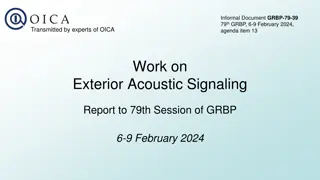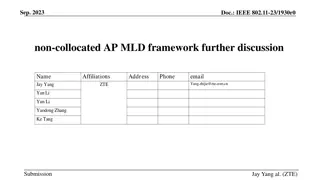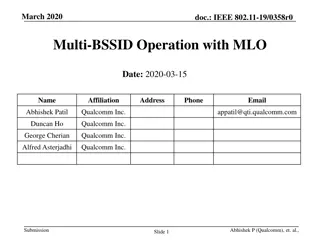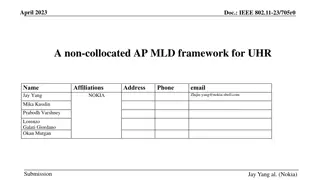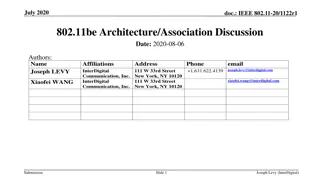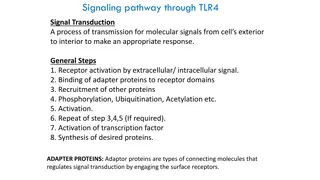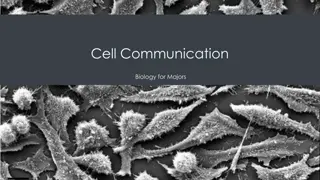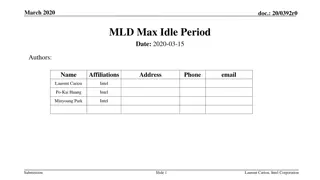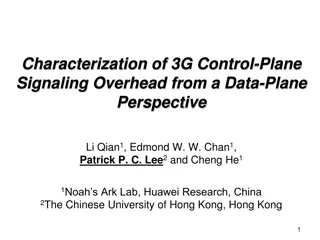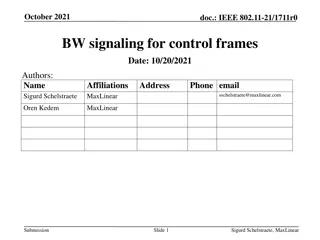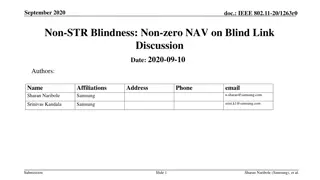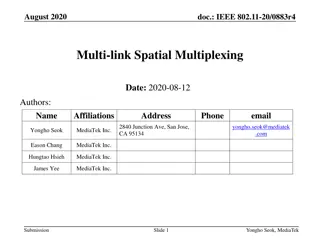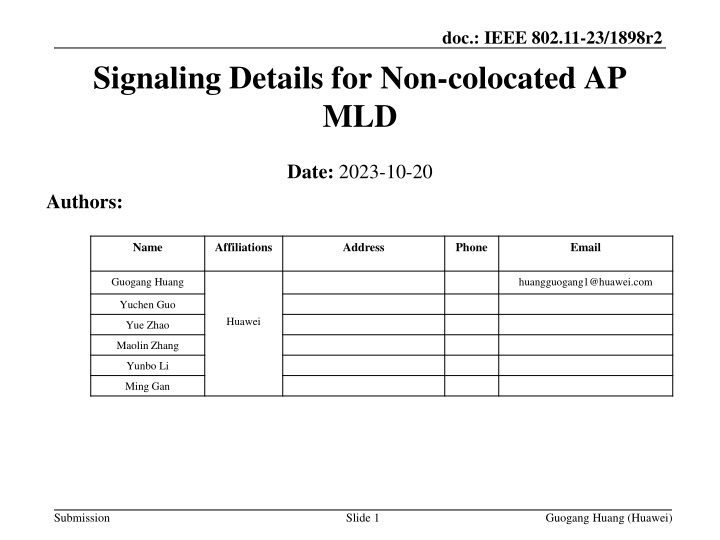
IEEE 802.11-23/1898r2 Signaling Details for Non-Colocated AP MLD
Explore the signaling details and procedures for non-colocated AP MLD in the IEEE 802.11-23/1898r2 standard update, including architecture, identification methods, and discovery processes for seamless roaming and connectivity.
Download Presentation

Please find below an Image/Link to download the presentation.
The content on the website is provided AS IS for your information and personal use only. It may not be sold, licensed, or shared on other websites without obtaining consent from the author. If you encounter any issues during the download, it is possible that the publisher has removed the file from their server.
You are allowed to download the files provided on this website for personal or commercial use, subject to the condition that they are used lawfully. All files are the property of their respective owners.
The content on the website is provided AS IS for your information and personal use only. It may not be sold, licensed, or shared on other websites without obtaining consent from the author.
E N D
Presentation Transcript
doc.: IEEE 802.11-23/1898r2 Signaling Details for Non-colocated AP MLD Date: 2023-10-20 Authors: Name Affiliations Address Phone Email Guogang Huang huangguogang1@huawei.com Yuchen Guo Huawei Yue Zhao Maolin Zhang Yunbo Li Ming Gan Submission Slide 1 Guogang Huang (Huawei)
doc.: IEEE 802.11-23/1898r2 Introduction Current UHR proposals [1-5] have discussed the following aspects The non-colocated AP MLD (or called roaming AP MLD) architecture for the seamless roaming should be an optional feature for 11bn. The UHR non-AP MLD can associate with an AP MLD or a non-colocated AP MLD. But the EHT non-AP MLD cannot associate with a non- colocated AP MLD. The AID space should be at the AP MLD level. The link of a non-colocated AP MLD can be identified by colocated set ID + Link ID In this presentation, we will discuss the related signaling on the non-colocated AP MLD and the roaming procedure. Non-colocated AP MLD Non-colocated AP MLD common MAC MLD common MAC MLD common MAC AP 2 AP 1 AP 1 AP 2 Current AP MLD Neighboring AP MLD STA 2 STA 1 MLD common MAC Non-AP MLD Submission Slide 2 Guogang Huang (Huawei)
doc.: IEEE 802.11-23/1898r2 Recap Non-colocated AP MLD Each non-colocated AP MLD has a MAC SAP which is uniquely identified by a MAC address of the non- colocated AP MLD. The DS will delivery the MSDU that are destined for a given UHR non-AP MLD which associates with the non-colocated AP MLD to the non-colocated AP MLD through the corresponding DS SAP and MAC SAP. After the processing of the MLD upper MAC sublayer of the non-colocated AP MLD, the non- colocated AP MLD will delivery the encrypted MPDUs to one or more MLD lower MAC sublayers for transmission through the newly defined wired or wireless interface between the MLD upper MAC sublayer and the MLD lower MAC sublayer. Note that the PTK cannot be distributed among AP MLDs which are affiliated with the same non- colocated AP MLD from the security point of view. Non-colocated AP MLD Non-colocated AP MLD common MAC MLD common MAC MLD common MAC AP 2 AP 1 AP 1 AP 2 Current AP MLD Neighboring AP MLD STA 2 STA 1 MLD common MAC Non-AP MLD Submission Slide 3 Guogang Huang (Huawei)
doc.: IEEE 802.11-23/1898r2 How to identify a link Generally, the link of the non-colocated AP MLD can be identified by using the following options Option 1. AP MLD MAC Address + Link ID Option 2. AP MLD ID + Link ID, wherein the AP MLD ID is assigned by the AP MLD. Option 3. Colocated set ID + Link ID, wherein the colocated ID is assigned by the non-colocated AP MLD. [1-2] Comments Considering the AP MLD MAC Address is always present in the Basic Multi-link element and the Reconfiguration Multi-link element, option 1 can work very well. For option 2, since the AP MLD ID is assigned by the AP MLD, it shall be parsed from the corresponding AP MLD s perspective. For option 3, considering we already had defined the AP MLD ID, there is no much need to define a colocated set ID which has a similar function. Submission Slide 4 Guogang Huang (Huawei)
doc.: IEEE 802.11-23/1898r2 Discovery of non-colocated AP MLD Considering an AP MLD affiliated with a non-colocated AP MLD shall be visible for both the EHT non-AP MLD and the UHR non-AP MLD, the simplest way is to include a Non-colocated AP MLD MAC Address field and corresponding present bit within the Basic Multi-link element, as shown in the below Fig. 1. For the Beacon and Probe Response frames, if the AP MLD is affiliated with a non-colocated AP MLD, then the corresponding Non-colocated AP MLD MAC Address field is present. Otherwise, the Non-colocated AP MLD MAC Address field is not present. If the Non-colocated AP MLD MAC Address field is present in the Basic Multi-link element of Authentication and (Re)Association Request frames, it means the UHR non-AP MLD requests to associate with the indicated non-colocated AP MLD. Otherwise, the UHR non-AP MLD requests to associate with the current AP MLD. Meanwhile, the AP MLD ID is present to indicate which AP MLD of corresponding links are be requested. Common Info field Link Info field Element ID Extension (=107) Common Info Length Non-colocated AP MLD MAC Address Non- colocated AP MLD ID Element ID (=255) Multi-Link Control MLD MAC Address AP MLD ID Per-STA Profile x (STA x) Per-STA Profile y (STA y) ... Length ... ... ... Presence Bitmap Subelement ID (=0) Reserved Type (=0) Length Data Fig. 1 Basic Multi-link element Submission Slide 5 Guogang Huang (Huawei)
doc.: IEEE 802.11-23/1898r2 Discovery of non-colocated AP MLD (Cont.) Since maybe there are multiple non-colocated AP MLDs with different SSIDs, a non- colocated AP MLD ID is defined to indicate which non-colocated AP MLD the corresponding AP MLD is affiliated with. Specifically, Define an Extend MLD Parameters subfield for the RNR element, as shown Fig. 2. A Non-colocated AP MLD ID subfield and the corresponding present bit is included within the Basic Multi-link element, as shown in Fig. 3. B0 B22 B23 B0 B7 BSS All Disabled Link Indication Non-colocated AP MLD ID AP MLD ID Link ID Parameters Change Count Updates Included Reserved Reserved Extend MLD Parameters subfield MLD Parameters subfield Fig. 2 Extend MLD Parameters subfield Common Info field Link Info field Element ID Extension (=107) Common Info Length Non-colocated AP MLD MAC Address Non- colocated AP MLD ID Element ID (=255) Multi-Link Control MLD MAC Address AP MLD ID Per-STA Profile x (STA x) Per-STA Profile y (STA y) ... Length ... ... ... Presence Bitmap Subelement ID (=0) Reserved Type (=0) Length Data Fig. 3 Basic Multi-link element Submission Slide 6 Guogang Huang (Huawei)
doc.: IEEE 802.11-23/1898r2 Roaming Procedure In the non-colocated AP MLD, the non-AP MLD shall exchange Link Reconfiguration Request/Response frames with the current AP MLD to add links with neighboring AP MLDs. It s reasonable to allow that the non-AP MLD can exchange Probe Request/Response frames with the current AP MLD to get the info on neighboring AP MLDs affiliated with the same non-colocated AP MLD. The link reconfiguration procedure is shown in the below Fig. 5. Non-colocated AP MLD Non-colocated AP MLD common MAC MLD common MAC MLD common MAC AP 2 AP 1 AP 1 AP 2 Current AP MLD Neighboring AP MLD STA 2 STA 1 MLD common MAC Non-AP MLD Fig. 5 Link reconfiguration procedure Fig. 4 Non-colocated AP MLD architecture Submission Slide 7 Guogang Huang (Huawei)
doc.: IEEE 802.11-23/1898r2 Link Reconfiguration Since the AID space is at the AP MLD level [4], a new AID will be assigned when adding links with an AP MLD which is affiliated with the same non-colocated AP MLD. Hence, an AID subfield and a corresponding present bit are included within the Basic Multi-link element. If multiple serving AP MLD mode [4] is considered, the info on each AP MLD is signaled through a separate Basic Multi-link element. In other words, one or more Basic Multi-link elements are included Request/Response frames. within Link Reconfiguration Common Info field Non-colocated AP MLD MAC ... Link Info field Element ID Extension (=107) Common Info Length Non- colocated AP MLD ID Element ID (=255) Multi-Link Control MLD MAC Address AP MLD ID Per-STA Profile x (STA x) Per-STA Profile y (STA y) ... Length ... AID Address ... Presence Bitmap Subelement ID (=0) Reserved Type (=0) Length Data Fig. 6 Basic Multi-link element Submission Slide 8 Guogang Huang (Huawei)
doc.: IEEE 802.11-23/1898r2 Enhanced security For the AAD construction of the individually addressed MMPDU in 11be, A1, A2 and A3 are the corresponding STA MAC address of the link on which the corresponding MMPDU is sent, respectively. This manner requires the re-encryption of the individually addressed MMPDU when it is retransmitted through another link. This will increase the retransmission delay especially under the non-collocated MLD architecture. Hence, we propose to define a new mode for the AAD construction of the individually addressed MMPDU, i.e. A1, A2 and A3 are the corresponding MLD MAC address, respectively. Furthermore, for a link- specific individually addressed MMPDU, an MLO Link Information element shall be included within the frame body. This new mode can be enabled during the (Re)association Request/Response frame exchange. For example, an Management Frame Protection Enhanced Mode Enabled bit within the RSN Capabilities field of the RSNE or within the Extended RSN Capabilities field of the RSNXE. Submission Slide 9 Guogang Huang (Huawei)
doc.: IEEE 802.11-23/1898r2 References [1] 11-22-1910-03-0uhr-seamless-roaming-for-uhr [2] 11-23-0170-01-0uhr-smooth-roaming-discussion [3] 11-23-0231-00-0uhr-thoughts-on-seamless-roaming-under-the-non-collocated-ap-mld-architecture [4] 11-23-0632-00-0uhr-smooth-roaming-follow-up [5] 11-23-1416-00-0uhr-seamless-roaming-follow-up Submission Slide 10 Guogang Huang (Huawei)
doc.: IEEE 802.11-23/1898r2 SP 1 Do you support to use the link ID plus the AP MLD MAC address to identify a link under the roaming AP MLD architecture? Yes: No: Abstain: Submission Slide 11 Guogang Huang (Huawei)
doc.: IEEE 802.11-23/1898r2 SP 2 Do you support to reuse the current Basic Multi-link element to signal the info (e.g. roaming AP MLD MAC address) on the roaming AP MLD? Yes: No: Abstain: Submission Slide 12 Guogang Huang (Huawei)
doc.: IEEE 802.11-23/1898r2 SP 3 Do you support to define a new mode for the AAD construction of the individually addressed MMPDU, i.e. A1, A2 and A3 are the corresponding MLD MAC address, respectively? Yes: No: Abstain: Submission Slide 13 Guogang Huang (Huawei)

